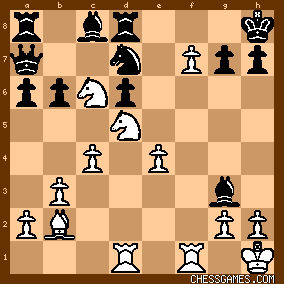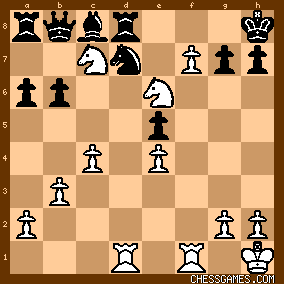|
< Earlier Kibitzing · PAGE 4 OF 4 ·
Later Kibitzing> |
| Jun-29-13 | | cyclon: I'm not quite sure of this puzzle ( rather 'obscure' ), but let's say 18. fxe6 and best seems to be 18. -Nf6. In case of 18. -fxe6 might come 19. Nxe6 Bxg3 ( 19. -Qb8 or wherever, 20. Nd5 and White is winning ) 20. Nxc7 Ra7 21. hxg3 Rxc7 22. Nd5 Rc5 ( or 22. -Ra7/b7 23. Ne7+ Kh8 24. Rf7 curfew ) 23. Bd4 Ra5 24. Ne7+ Kh8 25. Nc6 wins the exchange with pawn up and in general better position. Then, after 18. fxe6, if 18. -f6, comes 19. E7 ( point with this pawn move is to PREVENT Black's Queen coming to -c5 pinning the Knight on d4 ) 19. -Bxg3 ( or 19. -Re8 20. Ne6 and either winning material or mating on -g7 ) 20. Nd5 and now the BQ cannot come to -c5 for OTHER reason ( 21. exd8Q+ ). White wins. Other BLack's Knight moves gets 19. Rxf7 with the pawn and the bind. Then back to ( my ) main-line 18. fxe6 Nf6. White plays simply 19. exf7+ winning a pawn in the more active position. Whether Black plays 19. -Kf8/-Kxf7/-Kh8/-Qxf7, White might move calmly for example 20. Qh4 intending 21. Nd5 with a very promising game for him, but not yet with forced short-cut win. This is the best I found for both. One more line after 18. fxe6 is that if Black plays immediately 18. -Bxg3, then White moves 19. exf7+ Kh8 20. Ne6 Q- ( or 20. -Be5 21. Nxc7 R- 22. Ne6 winning material ) 21. Nxd8 and in these interesting resulting positions ( depending with differings where Black moves his Queen on 20 th ) White clearly plays for the win. Diagram position contains probably more variations still and I wonder whether Aljechin found something else. Never knew about him. |
|
| Jun-29-13 | | cyclon: Quite so it went with the difference that I had White King in the diagram position for some reason in g1 and not in h1 where it should be. That doesn't change in this case the basic combinational idea of White's though. |
|
| Jun-29-13 | | kevin86: White is a queen down-but black can't save the game! |
|
| Jun-29-13 | | Marmot PFL: Seeing the board I didn't have much trouble finding 18 fe6 Bxg3 (fe6 19 Nxe6) 19 ef7+ Kh8 20 Nd5 20...Qb7 21 Ne6 Be5 22 Bxe5 de5 23 Nxd8
20...Qa7 (or 20...Qb8) 21 Nc6
Still a great blindfold achievement, especially if Alekhine was also playing other games. |
|
Jun-29-13
 | | Jimfromprovidence: If 20 Ne6?! then 20...Qb8 (where it is not under attack any more) then 21 Nd5 below.
click for larger view Sure, there is a mate in one-threat now but black handles it with 21..Bd5. 
click for larger viewThe point of 20 Nd5 is that it offers better attacking possibilities. So after 20...Qa7, then 21 Nc6, below. 
click for larger view Here you are both threatening the queen and the rook at d8; now if white captures the rook there is also a back rank mate threat black has to deal with. |
|
| Jun-29-13 | | Lykos: Longest variant I found:
20. Nd5 Qc5
21. Ne6 h6!
22. Nxc5 bxc
23. Nc7 Rb8
24. NeB! Bb7
25. hxg3 Bxe4
26. Rxd6 Nf8
27. Bxg7+ Kh7
28. Bxf8 Bg6
29. Rxd8 Rxd8
29. Be7
So I think Rybka was wrong, Alekhine right. |
|
| Jun-29-13 | | Calli: Neither player was blindfold. Alekhine annotates the game in My Best Games (1908-1923) and gives it as an Exhibition game played in Berlin in February, 1923. |
|
| Jun-29-13 | | whiteshark: <Calli> The German edition of My Best Games (1908-1923), game 97 says:
"Freie Partie, Berlin, Februar 1923. <Beiderseits ohne Ansicht des Brettes>" which prism translates the last part as 'On either side without a view of the board' |
|
| Jun-29-13 | | Calli: <Whiteshark> Interesting. I believe the English translation (J. Du Mont & M. E. Goldstein) was first in 1927 with the German in 1928. The original manuscript is in French, but sat around for years because no French publisher could be found. I don't think Kotov or Skinner/Verhoeven designate this as a blindfold either. |
|
| Jun-29-13 | | whiteshark: A footnote in the German book says that there's a Russian edition from 1926.
- -
I think the following sums it up: "the exact conditions of this one-on-one contest were not spelled out" http://www.blindfoldchess.net/blog/... |
|
| Jun-29-13 | | vajeer: <Lykos: Longest variant I found: 20. Nd5 Qc5
21. Ne6 h6!
22. Nxc5 bxc
23. Nc7 Rb8
24. NeB! Bb7
25. hxg3 Bxe4
26. Rxd6 Nf8
27. Bxg7+ Kh7
28. Bxf8 Bg6
29. Rxd8 Rxd8
29. Be7
So I think Rybka was wrong, Alekhine right.> In your variation, one possible variation for black could be 22...Nf8. Don't know for sure if that is better than bxc5 |
|
| Jun-29-13 | | Calli: <WS> "we recently discovered a game in which they both played blindfolded' - Hearst Except that it is in My Best Games, one of the most famous chess books of all time. Alekhine later published Deux Cent Parties d Echecs in French. It is Best games Vol 1 plus games from the years 1924-1927. Perhaps that volume would be conclusive in answering the question. |
|
| Jun-29-13 | | Lykos: Vajeer:
I believe 22.Nf8
is no better. The trick with Nc7 and Ne8 could work here too. |
|
| Jun-29-13 | | James D Flynn: Material is equal but Black’s pieces are passively placed whereas White’s are active and ominate the centre,
18.fxe6(sacrificing the Q to take advantage of Black’s back rank weakness) Bxg3 19.exf7+ Kh8(f8 is guarded by 2 pieces and the push f8+ is supported only by 1) 20.Ne6(attacking both Q and R) Qa7 21.Nb5(Threat Bxg7#) Be5 22.Bxe5 dxe5(if Nxe5 f8+ mates) 23.Rxd7 Bxd7 24.Nxd8 Rxd8 25.f8+ Rxf8 26.Rxf8=Q# |
|
| Jun-29-13 | | cyclon: < Jimfromprovidence: If 20 Ne6?! then 20...Qb8 (where it is not under attack any more) then 21 Nd5 below.
Sure, there is a mate in one-threat now but black handles it with 21. -Be5 > Are you sure?. NO MATTER how crazy it might seem, but 22. Bxe5 dxe5 ( what else? ) 23. Ndc7 seems to give White winning chances. It's late and I'm tired, so I haven't analyzed it fully. It would be nice to know how you save Black. |
|
Jun-29-13
 | | Jimfromprovidence: <cyclon> <Are you sure?. NO MATTER how crazy it might seem, but 22. Bxe5 dxe5 ( what else? ) 23. Ndc7 seems to give White winning chances. It's late and I'm tired, so I haven't analyzed it fully. It would be nice to know how you save Black.> That's a great threat. I never saw it coming. Here is your position. 
click for larger view White threatens 24 Ne8!, promoting his pawn. Black has 23...Rg8 in response. After 24 fxg8Q Kxg8 25 Nd5, below... 
click for larger view...white has the threat of 26 Ne7+ Kh8 27 Ng5, but black escapes by the skin of his teeth with 25...Nf6. 
click for larger view |
|
| Jun-29-13 | | MostlyWatch: Instead of taking the queen, I'd say hop the knight out to get him away from the pawn, and also block the rook's file. When the pawn takes the pawn you can take the pawn with your queen. That gets her in the game and breaks up the fork danger. White has to move his queen. It doesn't win the game immediately but gets you a little breathing room. |
|
| Jun-29-13 | | Alien Math: <whiteshark> her find 1927, 1928 Russian editions of <Мои лучшие партии. Книга первая (1908-1923)> are <My best games. First book (1908-1923)> http://chessm.com/catalog/category-... |
|
| Jul-30-15 | | ToTheDeath: This game made a big impression on me when I first saw it as a young man. Years later it still is a remarkable miniature. Black appears only a bit worse after 16...b6. To turn this into a crushing win with a queen sacrifice and a pawn promoting on f8 in only 4 more moves is what made Alekhine one of a kind. |
|
| Jul-30-15 | | whiteshark: Good find, <Alien Math>. TY |
|
| Jul-30-15 | | whiteshark: <20.Nd5!> "The point of Alekhine's combination. The combined force of the remaining pieces dominates the board, despite Black's huge material advantage. Saemisch was so terrified by the opponent's multiple threats that, to the surprise of the audience, he simple resigned! In fact all variations prove that his decision, although a bit premature, was fully justified!" -- Kasparov |
|
Sep-06-22
 | | kingscrusher: How is this game not in more than 100 collections - maybe the game was added later on in the Chessgames database or something? It was featured for study in this video:
https://www.youtube.com/watch?v=smk...
About 1 hour 35 in to it |
|
Sep-06-22
 | | MissScarlett: The gid in the url is an indicator of when it was added to the DB. <gid=1012164> is positively antediluvian. |
|
Sep-07-22
 | | Dionysius1: The more I look at the final position the more nightmarish it becomes. If I ever open my planned games collections of "Games that make me laugh" and "Games that make me cry", this will be in the latter. |
|
Mar-03-24
 | | kingscrusher: A great game to revisit once in a while. Even Alekhine is missing the powerful Nf5 at a couple of points in this game like at move 16 - but the underlying tempo gain themes are seen in the final position a bit. |
|
 |
 |
|
< Earlier Kibitzing · PAGE 4 OF 4 ·
Later Kibitzing> |





